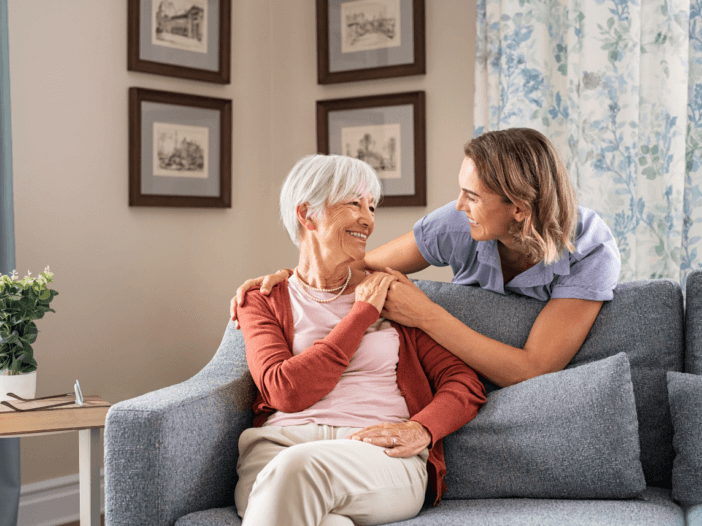
Rather than moving into assisted living facilities or nursing homes, most older adults are aging in place and remaining in their homes and communities.
For those who wish to maintain their independence and continue living at home as they grow older, taking certain steps to protect their physical, mental, and financial welfare is essential.
What Does It Mean to Age in Place?
The Centers for Disease Control and Prevention defines aging in place as a senior’s “ability to live in one’s own home and community safely, independently, and comfortably, regardless of age, income, or ability level.” According to 2021 data from AARP, more than three-quarters of adults 50 and older say they would prefer to age in place.
Health Considerations for Older Americans Aging in Place
Older adults must consider their physical, emotional, and social well-being when deciding where to spend their later years. They may consider adding supplemental services over time to help improve their quality of life.
To ensure that you will have the support you need for safely aging in place, take the following into consideration:
Resources to Manage Chronic Diseases
Disease management is vital for anyone, especially an older person with a chronic illness. Many older people suffer from at least one chronic illness. If a senior has a chronic disease and wants to age in place, they and their caregivers should focus on:
- Ensuring that spaces in the home are safe and easily accessible to make getting around easier
- Learning about proper nutrition
Eating Well While Aging at Home
Proper nutrition is a vital part of caring for yourself at home. In facing potential changes to your financial situation after retirement, you may need help buying nutritious meals even after budgeting.
If you find yourself in need of meals, community resources may be available. Neighborhood senior centers and charities may provide a hot meal while you make new friends. If you cannot leave your home, some meal delivery services drop off food at your door for little or no cost.
Support for Mobility
Exercise and maintaining your mobility can increase overall physical and mental health even as you grow older. Seniors aging in place need to be able to move around their homes and neighborhoods safely. Aging in place is a much more realistic goal if you can walk for exercise, access transportation to medical appointments and errands, and maintain a safe environment at home, free from increased fall risks.
If you desire to age in place, consider simple changes you can make to your home to promote your safety. Examples of helpful modifications around the house include handrails, temporary ramps, no-slip bath rugs, and assistive seating.
Mental Health, Substance Abuse, and Memory Care Services
There is an increased need among older adults for mental health, substance abuse, and memory care services. An estimated 20 percent of older adults have a mental health disorder, and the total number of seniors with a mental health or memory care diagnosis is likely to increase over time.
Suggestions for addressing mental health concerns among older people include:
Focusing on preventative care. Seniors and their caregivers should work with their primary care physician to identify warning signs of depression, anxiety, other mood disorders, and memory care problems. Preventative care can help mitigate the progress of these disorders and improve quality of life.
Looking for common signs of a substance abuse problem. This is an often overlooked area of older adult mental health care. Older adults may turn to substances to deal with unresolved childhood problems or to avoid a feeling of loss of meaning and purpose. Some common signs to watch for include reduced hygiene, unexplained bruises, erratic behavior, and the smell of alcohol on their breath.
The Need for Social Connection Among Aging Adults
Older adults benefit tremendously from social connections and interaction. People over 65 are likely to live alone, so creating a community outside the home is necessary. Feeling a sense of purpose is beneficial to mental and physical health. For seniors looking to create a sense of community and purpose, they may benefit from such activities as:
- Joining an organization or social club
- Volunteering for a cause close to their hearts
- Learning a new hobby
- Attending a religious institution
- Adopting or fostering a pet
- Using technology to stay in touch with friends and family
Wearables and Smart Monitoring Devices
Technology can help us not only remain connected to one another, but also monitor our health and that of our aging loved ones. Many devices make detailed health information readily available at our fingertips. These devices benefit seniors because they can learn more about their health and make the most of doctor’s visits by communicating effectively about their medical needs.
Examples of wearable health and smart-home monitoring devices include:
- Smartwatches and smartphones, which can track your cardiac health, fitness activity, and sleep patterns
- Medical alert bracelets and personal alert necklaces, which can aid in detecting falls or contacting emergency services when necessary
- Contact sensors and smart locks, devices that can alert caregivers when their loved one living at home leaves a window, garage, or door open, or has forgotten to lock them
- Smart plugs, which can automatically turn on and off lights, space heaters, thermostats, security cameras, and more
Money Management While Aging in Place
Money management can also be an area of concern for seniors and caretakers. Seniors want to make sure they have sufficient financial resources to remain in their homes and communities comfortably, eat well, care for their medical needs, and have fun.
Creating a budget with the help of financial counselors and geriatric care managers can benefit someone on a fixed income. There may even be volunteers in your area that offer a similar service. Being aware of how to prevent and avoid common types of scams that target the senior population is equally as important.
How Can Caregivers Help Seniors Age in Place?
Seniors often choose to age in place to remain independent and avoid becoming a burden to their family. Caregivers can support their goal by teaching them to use technology to communicate and track their health, helping them establish a budget, and setting them up with a routine that may include visiting their doctor, running errands, and making time to socialize.
There is nonmedical support that your loved one will need, too. Caregivers may opt to support their aging loved ones by pitching in with or hiring services for lawn care, cleaning, cooking, laundry, or pet care.
Is Aging in Place Right for You?
Careful planning is the best way to accomplish your goal of staying home as you age. If you are considering plans to age in place and want assistance, find a qualified elder care attorney to learn more about your options.
